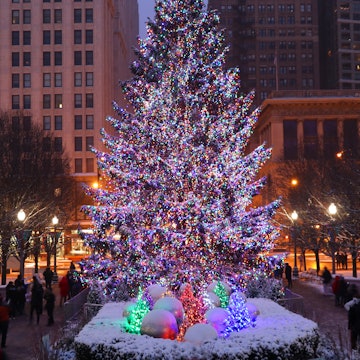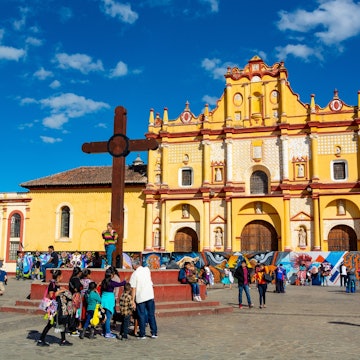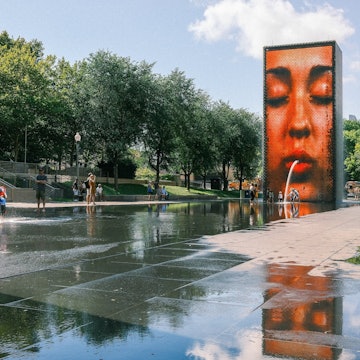

Cathedral Rock in Sedona, Arizona. Matthew Noll/Shutterstock
Arizona has its icons of the American West, but there's more to the Grand Canyon State than you might expect.
This place is not just desert – it has a trio of distinctive wine-producing regions, the first international dark sky community and it's where Pluto was discovered. Where else can you strap on your skis and hit the slopes just an hour away from stands of saguaro cacti? In Arizona, you’ll find everything from hidden hot springs and prehistoric cave dwellings to Frank Lloyd Wright’s organic architecture. These are the best experiences you can have when you get there.
1. Take a hot-air balloon ride in Sedona
Exploring Sedona’s landscapes could take a lifetime. An electrifying way to see this high desert city, set amid two million acres of the Coconino National Forest, framed by ancient red rocks and famed for its unspoiled beauty and mysterious vortexes, is on a hot-air balloon ride. Float above swathes of ponderosa pines and the crests of sandstone landmarks such as 5000ft Cathedral Rock, Sedona’s most photographed site.
Planning tip: Balloon trips take off before dawn, so early risers can witness the desert stirring to life. Mornings are also prime time for photography. Trips run year-round but if you visit Sedona in winter, you might even see the desert dusted in snow.
2. Look into galaxies far, far away at Lowell Observatory
Lowell Observatory in Flagstaff has two celestial claims to fame. In 1930, its astronomers were the first to discover Pluto and in 2001, Flagstaff became the world’s first international dark sky city (one of five in Arizona).
At the observatory, get schooled on a universe of discoveries during guided tours such as Mars Hill, which takes visitors back to 1894 when Percival Lowell founded the observatory. Check out the Pluto Discovery Telescope and the 124-year-old, 24-inch Clark Refractor that Lowell first used to study Mars. Peer into space through six state-of-the-art telescopes on the Giovale Open Deck Observatory.
Planning tip: Pay a visit to the recently opened Astronomy Discovery Center. The 40,000ft structure is packed with interactive, educational and fun features that teach budding astronomers of every age about distant galaxies.

3. Learn about the area's prehistoric people at Tuzigoot National Monument
Remnants from Arizona’s prehistoric people have been well preserved throughout the state. At Tuzigoot National Monument in historic Clarkdale, you can actually walk inside a 110-room pueblo. Built by the Sinagua people 1000 years ago, the pueblo sits on a small hill overlooking the Verde River. Inside the visitor center is a small museum with artifacts unearthed from the pueblo, such as textiles, ceramics and tools.
Planning tip: Your visitor pass for Tuzigoot can also be used at Montezuma Castle National Monument within seven days. Stretch your cents even further with a selection of fun, free activities in Arizona.
4. Taste the grapes along the Verde Valley Wine Trail
Wine production might seem out of place in Arizona, but the Jesuits planted grape vines here in the 17th century. The state has three distinct wine regions. Two located in the south, Sonoita and Willcox, have the coveted American Viticultural Area (AVA) designation. The Verde Valley in central Arizona’s mile-high desert is aiming to earn its own geographic pedigree. The region is ripe for discovery on the Verde Valley Wine Trail.
More than 25 wineries and tasting rooms have cropped up in the historic cities of Jerome, Clarkdale, Cottonwood and Cornville. These communities are coaxing an impressive range of grapes out of the rocky limestone soil. Expect to taste wines made from chardonnay, riesling, malbec and tannat, a red wine grape from Europe’s Basque region.

5. Find quiet at the North Rim of Grand Canyon National Park
There’s nothing overrated about the 1.2-million-acre Grand Canyon National Park. If you’ve already visited the South Rim or are seeking more solitude and cooler temperatures, a trip to the North Rim is essential.
A network of trails offers panoramas of the mile-deep canyon’s vast and varied rock formations. There’s no village shuttle like at the South Rim, but that means plenty of scenic drives, such as Point Imperial, the park’s highest spot at 8803ft, which overlooks the Painted Desert.
Planning tip: The North Rim is open only from May 15 to October 15. From mid-October to December 1 (or as soon as snow closes the highway), you can visit the North Rim during the day.
6. Hit the country's southernmost slopes at Ski Valley
Snow sports in the desert? The southernmost spot for skiing in the US is just 45 miles from Tucson. Set atop 9157ft Mt Lemmon, Ski Valley is both a winter playground and summer retreat from southern Arizona’s triple-digit temperatures.
In 1881, Sara Plumber Lemmon made her inaugural ascent of her namesake peak on foot and by horse. Thankfully, you can ride the chairlift to the top to cruise 21 runs crisscrossing 200 skiable acres or hike the trails in summer. Watch out for wildlife such as coatimundi and Mexican spotted owls.
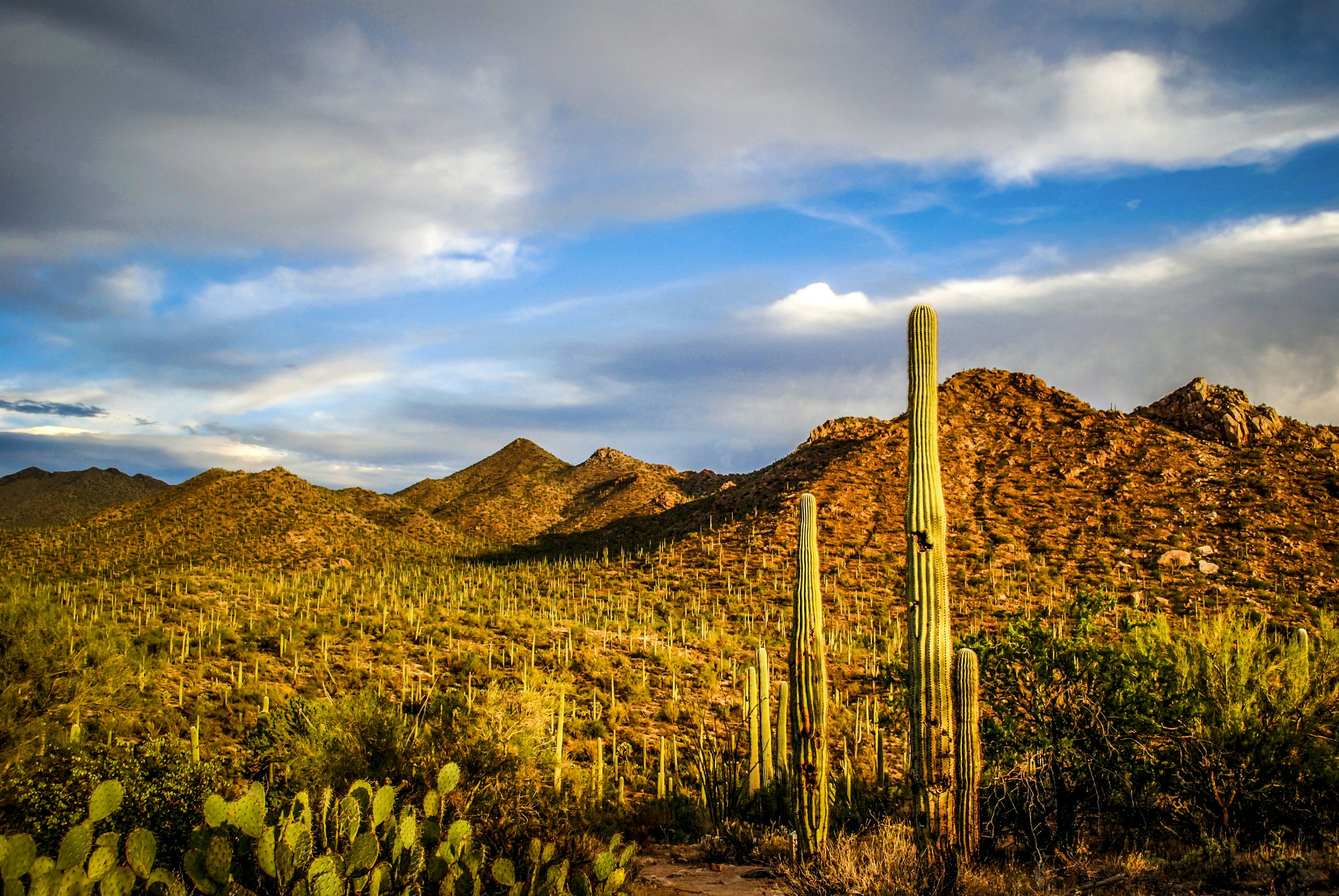
7. Walk among cacti at Saguaro National Park
Although you can see saguaro cacti in much of the Sonoran Desert, it’s an almost alien-like experience to travel among the masses of armed giants in Saguaro National Park.
Take a mini road trip through the park (Cactus Forest Drive is paved, but Bajada Loop is not), passing stands of century-old saguaros, which can tip the scales at up to 8 tons. Hike the trails to get up close to these spiky sentinels. Look for limestone kilns on the Cactus Forest Trail and petroglyphs at Signal Hill, which were made by the Hohokam people in the 13th and 14th centuries.
Planning tip: Visit from April to June to see the cacti heads and arms decked in frilly white blooms.
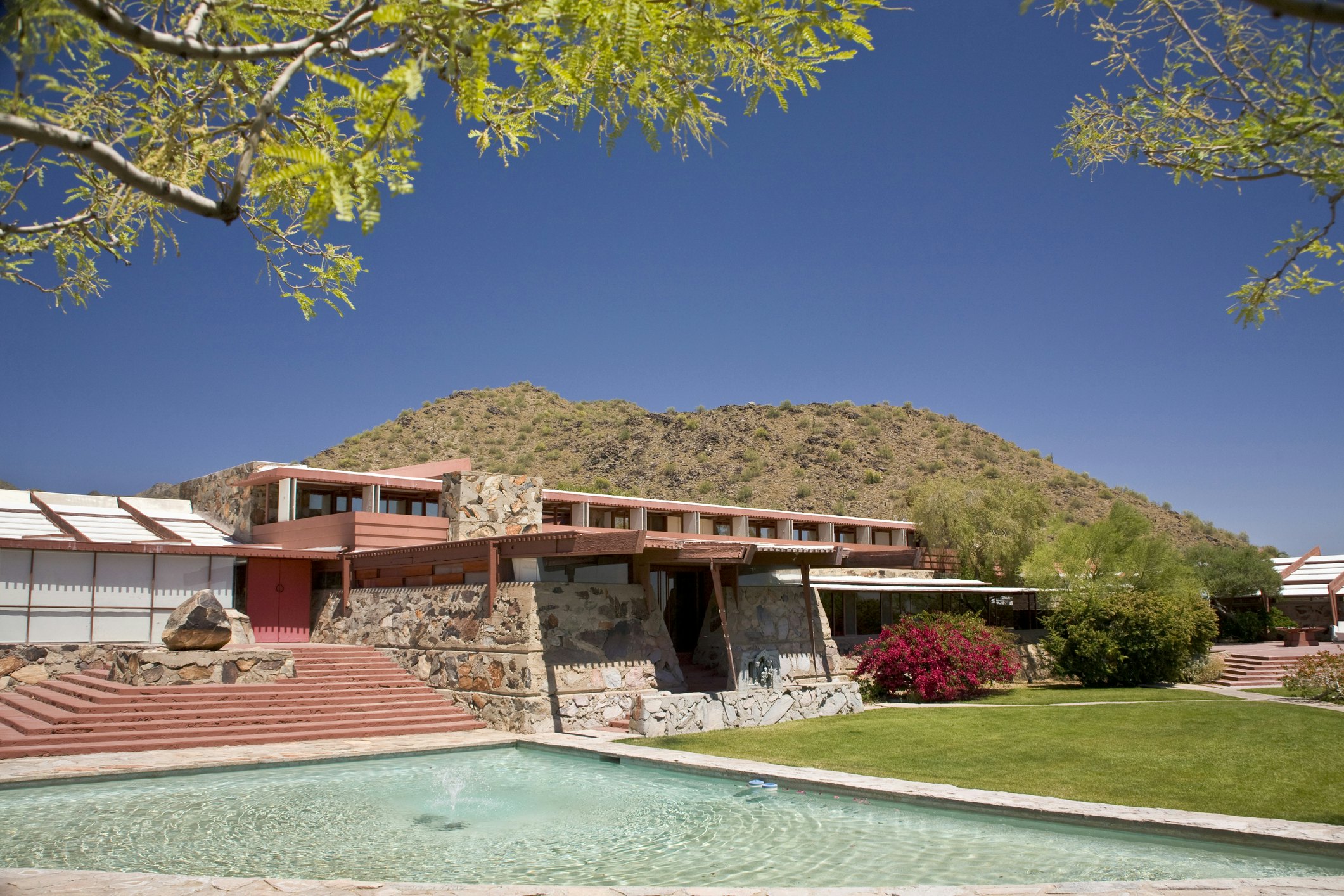
8. Admire the architecture of Taliesin West
In 1943, Frank Lloyd Wright said, “Taliesin West is a look over the rim of the world.” The father of modern American architecture was referring to his so-called desert laboratory, built in 1937 in Scottsdale.
A National Historic Landmark, Taliesin West was where Wright lived and worked in the winter. It was also a campus where he educated his protégés and pushed the boundaries of organic architecture. Tour the rooms and landscapes to see the unusual (a bathroom made from sheets of aluminum) and ancient (boulders with petroglyphs) elements throughout the property.
9. Understand tradition on the Navajo tribal lands
Arizona’s fascinating indigenous heritage dates back 12 millennia. Learn about these ancient and modern people by touring the Navajo tribal lands. Antelope Canyon, located in the Lake Powell Tribal Park east of Page, is a sacred site to the Navajo people. The slot canyon’s sculptural walls lit up with shafts of sunlight are a major draw. Book an authorized Navajo guide to see the handiwork of millions of years of erosion while delving into the area’s cultural significance.
About 125 miles east of Antelope Canyon, Monument Valley Navajo Tribal Park straddles the Arizona–Utah border. Another dramatic landscape created by wind and water, its monoliths have been immortalized in movies since the 1930s. Joining a local tour is required to explore much of Monument Valley, which is called se’Bii’Ndzisgaii in the Navajo language. Experiences often include driving the 17-mile route among imposing buttes such as East Mitten and West Mitten and learning about Navajo traditions.

10. Hike the Arizona Hot Springs Trail
Hot springs, slot canyons, a 20ft waterfall near the Colorado River, volcanic rocks and an arch-shaped like the Liberty Bell are why people hike the strenuous Arizona Hot Springs Trail, which connects to White Rock Canyon and Liberty Bell Arch trails. The trailhead is just 4 miles from the Hoover Dam. Depending on which route you take, the hike is 5 to 6 miles, with a 750ft elevation change.
Planning tip: The Liberty Bell Arch Trail is closed from May 15 to September 30.
11. Drive Route 66
The Mother Road (a term coined by John Steinbeck in The Grapes of Wrath) is legendary in Arizona, and for good reason. The original road from Kingman to Seligman is the longest uninterrupted stretch of historic Route 66 still in use. The highway travels through pastoral landscapes where eclectic towns give road-trippers a glimpse into the past.
Route 66 is a dose of Americana at its best: colorful and quirky, with oddities like the 14ft Giganticus Headicus outside the Antares visitor center. Make a pit stop at the historic Hackberry General Store (now a roadside museum) in its namesake village, and in Seligman get a cherry-dipped ice cream at Delgadillo’s Snow Cap.
12. Drink craft beer on the Flagstaff Brewery Trail
Flagstaff might best be known as the gateway to the Grand Canyon or for the Arizona Snowbowl’s winter terrain, but this mountain city has also become a destination for craft beer. Explore the Flagstaff Brewery Trail to taste what’s on tap at local spots such as Wanderlust, which elevates traditional brews to the next level: its Jasmine Terrace Rice Saison is made with puffed rice instead of wheat.

13. Be brave on the Grand Canyon Skywalk
Imagine seeing the base of the Grand Canyon beneath your feet while standing on a sheet of glass. Located in Grand Canyon West (not part of Grand Canyon National Park) on the Hualapai Indian Reservation, the glass-bottom Skywalk juts 70ft over the canyon’s west rim, curving in the shape of a horseshoe. The cantilevered bridge is just 10ft wide, but it can hold weight equivalent to 70 fully loaded 747s.
Planning tip: You can snap selfies at Eagle Point before you get on the Skywalk, but photography is not allowed on the bridge. Free lockers are available for stashing your stuff.
14. Walk across London Bridge in Arizona
Yes, it is the real London Bridge that spanned the River Thames – or at least one of them.
Built in 1831, Robert P. McCulloch purchased the bridge in 1964 when the British government put it up for sale. The cost at the time to buy the bridge? The princely sum of $2.46 million, now about $18 million. That’s not including dismantling it, transporting the masonry and rebuilding the bridge in Lake Havasu City.
Spanning the Bridgewater Channel and connecting the city to an island, the bridge is open to pedestrians, motor traffic and cyclists. In all, it’s a busy place with lots of boat traffic, boat-in-restaurant options, sandy beaches, shops, hotels and a dog park. McCulloch, who was extremely inventive, built what is now the Nautical Beachfront Resort: the state’s only beachfront resort.

15. Feed the burros, watch a gunfight and visit a haunted hotel
Long after the mines panned out and the miners moved on, the burros (donkeys) stayed behind. Now they roam the streets of Oatman, a stop on Route 66.
Gather for the staged gunfights, visit the many shops and buy biscuits to feed the burros that wait patiently in the dusty streets – this authentic western town hasn’t changed much in the last century or two.
Stop by the Oatman Hotel to peek into the room where silver screen actors Clark Gable and Carol Lombard supposedly spent their wedding night. The hotel also houses a museum with lots of interesting insight into the town’s mining history and its residents.
The food is great and the vibe is lively at the hotel’s restaurant and bar. Bring along a few dollar bills to tack onto the walls and ceiling – it’s a tradition here. If you get the feeling you're being watched, it may be one of the ghosts said to haunt the hotel. Included in that long list are Gable and Lombard and a distraught Irish miner who drank himself to death upon hearing about the loss of his family.
16. Explore Canyon Lake by steamboat
Cruise across the calm waters of Canyon Lake on the Dolly Steamboat near the memorably named town of Tortilla Flat. The steamboat’s boarding dock is accessible only by a winding road traversing through mountain canyons and high cliffs – a spectacular, if white–knuckle, ride.
Luckily, the narrated cruise is anything but harrowing. You'll enjoy gorgeous views as the 103ft double decker navigates through coves and inlets bordered by steep red rock walls, with saguaros and desert flowers peeking out from rocks and crevices. If you’d rather tour the lake on your own, kayak, paddle boat and boat rentals are available at Canyon Lake Marina.
For those who'd prefer to up their step count, there’s the Boulder Canyon Trail. Hikes vary in degree of difficulty from a moderate 4 miles to the 30-mile, multi-day backpacking loop. Along the way, stop at the Goldfield Ghost Town and Mine, a reconstructed 1893 town outside of Apache Junction with a train ride, gold mine tours, staged gunfights, museum, stores and eateries.
Planning tip: Carve out a little time to explore Tortilla Flat, the last remaining stop on what was the Apache Junction stagecoach route. Dine at the Superstition Saloon, visit the Country Store and stop at the Little Red School House to learn some local history, including the legend of the famed Lost Dutchman Mine.

17. Experience southern Arizona’s art scene
Abandoned and resettled several times since its founding in 1752, Tubac reinvented itself as an artist colony in the early 1900s. Even now with more than 100 shops, art galleries, restaurants and museums, the town retains much of its small-town charm. The historic adobe buildings and slightly dusty roads all add to the allure.
There are plenty of dining options, but Elvira’s is a standout for both its sophisticated Mexican cuisine and its history. The original opened as a takeout joint in Nogales, Mexico, in 1927. Still owned by the same family, the current location’s decor is all shimmering beads, lights, candles and art. See something you like? There’s a gift shop as well.
Nearby is the Tubac Presidio State Historic Park & Museum, Arizona’s first state park, where the remnants of the Mission San José de Tumacácori are located.
Planning tip: Mark your calendar for the Tubac Festival of the Arts, an annual celebration that's been going for over 60 years. Arizona has a wealth of festivals and celebrations that are worth timing a visit around.
18. Visit a historic stagecoach stop
Located on a 4000ft-high plateau, the Cameron Trading Post opened in 1916. A former stagecoach stop and now a restaurant, general store and hotel, it’s a popular choice for those in search of true wild west history.
The large Grand Canyon Dining Room, with its wide expanse of glass, huge stone fireplace and glossy wood paneling and cabinetry, offers American, Mexican and Navajo fare. For the latter, think fry bread, Yah-Ahtay chile and green chile stew along with prickly pear BBQ ribs.
There’s something for everyone in the general store, from high-end Navajo art, jewelry and pottery to handbags, clothing and jars of prickly pear cactus syrup – perfect for making your own margaritas back home.

19. Trail ride through the Sonoran Desert
When the White Stallion Ranch was founded in the late 1800s, Arizona had yet to become a state. Both nearby Tucson and Phoenix, about 100 miles north, had populations of just 5000 back then. Much has changed.
Many former ranches in Arizona are now subdivisions, but the White Stallion remains a guest ranch. It’s a place where families can enjoy trail riding through the Sonoran Desert, eating outdoors under the stars, sleeping in luxury cabins, taking a dip in the swimming pool or sitting around a campfire singing cowboy songs and watching lariat tricks.
Planning tip: Try to book your stay to include the Saturday night roast beef dinner, cooked entirely in the resort’s traditional Native American oven.
20. Dine at the Wrigley Mansion
When the Wrigley family (yes, the chewing gum) wanted to escape cold Chicago winters, they traveled to their home in Phoenix.
Set atop a rise with views of what was once just mountains and desert, but that now includes part of the city, it’s a step into another world of wealth and privilege.
Tours of the mansion are available, and some areas are open for wandering. The spacious house, a blend of Spanish, California Monterey and Mediterranean architecture, also includes two restaurants and a bar. The latter was formerly the original wood-paneled library.








